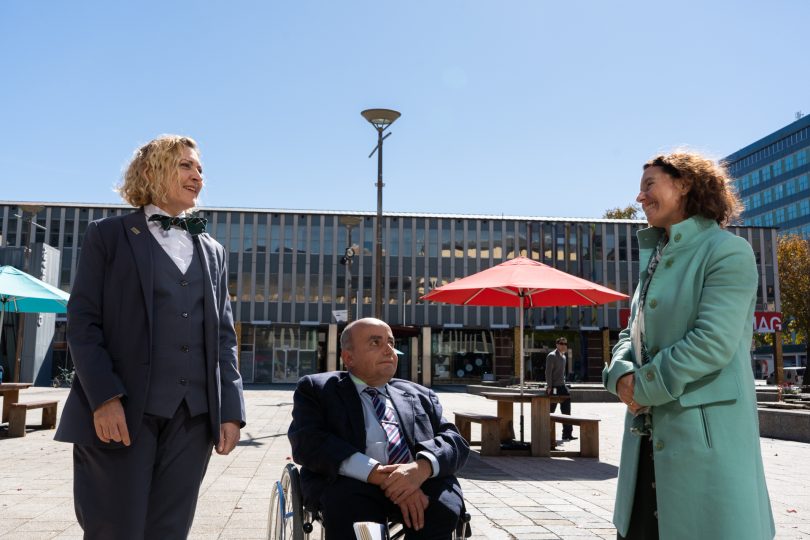
Minister for Disability Emma Davidson, ACTCOSS head of policy Craig Wallace, and Minister for Sustainable Building and Construction Rebecca Vassarotti. Photo: Dominic Giannini.
The ACT will lead a push for all new homes in Australia to be built to be accessible for people with a disability.
At Friday’s Building Ministers Meeting, ACT Minister for Sustainable Building and Construction Rebecca Vassarotti will call for mandatory accessibility standards in the National Construction Code so that all future homes, townhouses and apartments meet a threshold level of universal design.
“The standards will require simple features such as doors wide enough to accommodate wheelchairs and step-free access, a bathroom on the ground floor and structural reinforcements to allow for the installation of supports like grip rails if they are needed in the future,” Ms Vassarotti said.
The Labor-Greens Parliamentary Agreement commits the government to mandating all new homes be built to universal standards, and Ms Vassarotti says that if the changes to the National Construction Code are not agreed to by all Building Ministers, the ACT will go it alone.
ACTCOSS head of policy Craig Wallace welcomed the push, saying it was a big issue in the ACT where the number of people facing difficulties getting in and out of buildings and using facilities was increasing.
He said the number of Canberrans with a disability had increased from 16.2 per cent in 2015 to 19.4 per cent in 2018 and that this proportion would rise as the population ages.
“Time and again, we have heard gut-wrenching stories of people with disabilities and older Canberrans unable to find suitable housing in Canberra,” he said.
“We have people trapped in housing where their wheelchairs can’t get out the door; they can’t reach their cooktop; and older people who risk a devastating injury every time they take a shower or go to the toilet.”
He said a lack of well-designed housing limited housing choices for people with disability and contributed to them being overrepresented in group settings where they are often abused and lacked choice, independence and dignity.
“If we made some modest, manageable changes to design requirements during the initial builds, we could avoid people becoming homeless, entering nursing homes and losing their independence,” he said.
Executive officer of Rights & Inclusion Australia Michael Bleasdale said a change to the NCC would improve the lives of older people who wish to remain at home and people with impaired abilities, their families and carers.
He said research showed the benefits would outweigh the costs and would have a minimal impact on construction costs.
“The benefits include more opportunity for people with disability to live independent, productive lives, more choice for older Australians to age at home, and improved support for people with chronic illness or injury,” he said.
Mr Bleasdale said governments would also make significant savings across the aged care sector, the health sector and the National Disability Insurance Scheme (NDIS).
Ms Vassarotti said it was time for Australia’s construction code to be brought up to date.
She said Australia’s voluntary Livable Housing Design Guidelines had failed to provide adequate levels of accessible housing, with only 5 to 10 per cent of new homes in Australia being built to accessibility standards.
“Universal design has been standard in other countries like the United Kingdom, which first introduced basic accessibility requirements to its residential building regulations in 1999,” she said.
The proposed changes would add about 1 per cent to the average construction cost of new homes but would save thousands of dollars in expensive retrofitting to homes in the future, she said.
“Above all, they will mean that people are not forced out of their homes because they cannot be adapted to their needs,” Ms Vassarotti said.
She said the building industry needed to be supported to meet the new standards with reasonable timeframes for implementation, but it did need to fully commit to building homes that met community needs.





















